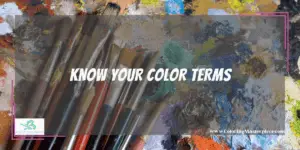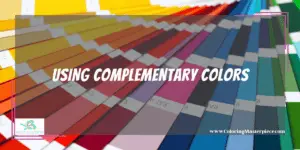Coloring can be enjoyed by all ages. Recently, adult coloring has seen a massive gain in popularity. And why shouldn’t it? More and more research is emerging all the time showing a link between coloring and decreased stress and anxiety levels. It’s even being compared to meditation as something that can provide the same type of benefits.
Selecting your colors is one of the most fun parts of coloring. Then, as you start working with them, you’ll see your vision coming to life in front of your eyes with a well-chosen color palette. As you get more experienced with coloring, you’ll learn what colors do together, apart, blended, in large quantities, and in every way they can be used. Choosing colors gets even more fun when you have several projects under your belt because you gain useful knowledge with each one.
Know Your Color Terms

You may already be familiar with the various color terms and categories, but in case you aren’t, we’ll just go over some of them that will help you when you’re deciding on your color palette. The most basic color groups are primary colors—red, yellow, and blue—and secondary colors—orange, green, and violet. From there you get the next group, the tertiary colors. These are colors that are made by mixing a secondary color with a primary color.
All colors are described as being on a color wheel. It contains the spectrum of all colors. The color wheel gets referenced a lot when you’re talking about color palettes.
Now we get the terms that aren’t as common, although you have probably heard them used before.
- Analogous colors – These are colors found next to each other on the color wheel, like blue and green.
- Complementary colors – These are across from each other on the color wheel. For instance, you’ll find the purple and yellow opposite of each other.
- Monochromatic colors – These are all the same color, just different shades of the one. For instance, you could have a picture consisting of all kinds of shades of red.
- Triadic colors – These are colors that are evenly spaced from each other on the color wheel. You can use triadic colors that are one step apart, two steps apart, three, or more. The number of steps is how many colors are in between each chosen color. It’s good for getting a vibrant picture that has colors that pop.
Assess Your Mediums and Decide What to Use
When you’re trying to choose a color palette for coloring, you need to know what colors are available as options. If you already have supplies, then assess what you have to decide on what kind of art medium you want to use. Are you going to be using colored pencils, crayons, gel pens, watercolors, markers, or something else? You can even decide to use a combination of different mediums.
Once you’ve decided on a medium, then you can start pulling out colors and placing them next to one another to see how they look together. The way your mind’s eye sees something and the way your actual eyes see it can be completely different, so this will help you to see if what you are considering for a color palette is going to work for what you’re looking for.
Learn to Limit Your Palette
Sometimes, we think the more colors we use, the better the result is going to be. But that’s not always the case. You’re going to find that some of the most dramatic and provocative-looking pictures are produced with a lesser number of colors.
Using carefully selected color schemes helps to evoke the feelings from the picture that you’re aiming to get. It’s a method that’s used all the time in advertising, merchandising, and other areas where manufacturers and other types of businesses are trying to get the audience or consumer to feel a specific emotion.
A simple example would be using colors that are already associated with something specific. If you’re trying to get people to think about Christmas, you’re not going to use a color scheme that’s all about pinks and purples. You would use red, green, silver, gold, and maybe white. Just seeing those colors together, even in the absence of any other kind of imagery will make many viewers think of the holiday season.
In the case of coloring, less can turn out to be more. So learning to limit your color palette will help you to produce more impactful colored pictures.
Get the Most Control with Analogous Colors
Choosing a color palette for coloring that is made of analogous colors will give you control over how the picture makes the viewer feel. As we mentioned above, these are the colors that are on the same side of the color wheel, right next to each other.
When you stick with colors from one section of the color wheel, you’ll get either a warm, cozy-feeling picture or a cool, calm-feeling picture. The warm colors are all of the reds, yellows, and oranges. The cool colors are the blues and greens.
Most of the time when you’re going with an analogous color scheme, you’ll use around three or four colors. Your picture will have a very harmonious look. You can add some contrast to it if you want by coloring in lighter and darker fashions. That’s what will give your picture some vibrancy.
Using Complementary Colors

Working with complementary colors for your color palette isn’t the easiest sometimes. The point of this type of color scheme is to make things pop in the picture. If you don’t do it quite right though, you end up with a picture that looks kind of a mess. That doesn’t mean you shouldn’t try it though. It is a fun process of learning how to use complementary colors to get desired outcomes.
When you start playing with the complementary colors, you can see the bright contrast you get from them when you put them right next to each other. If you layer them over each other, you’ll see the bright vibrancy disappear because when you mix them they create brown.
One thing you can do for a complementary color palette approach is to use one color to dominate the majority of the picture. Then take a complementary color to fill in the details surrounding it. Done correctly, you might even feel like the main part of the picture is popping right out of the page.
Get Inspired
You can find inspiration for color palettes virtually anywhere. Look around you when you’re out and about. If you see a bush full of flowers that you love the colors in, snap a quick picture of it. You can use that as a color palette for your coloring later.
Watching TV, you might see something that catches your eye because of the colors it includes. You can take a picture of that too. Or, note down the colors so you can use them in your coloring.
If you’re surfing around on the Internet, that’s a good place to find inspiration too. You might just run into something, or you can check out websites like Pinterest that are great at providing information and inspiration for color palettes of all types.
Magazines are also great for some inspiring creative boosts. You might see colors in a piece of jewelry you like, or an article of clothing, maybe even in a bed set. All you need to do is dog-ear the page or just rip the whole thing out of there so you have it as a reference when you’re pulling out the colors for your color palette.
There are color schemes throughout your entire environment. If you come across something you like, just find a way to save it so you can select your color palette for coloring based on that piece of inspiration.
Incorporate Neutrals
We’ll start by saying that a whole color palette full of neutrals isn’t going to produce a very nice picture. You’ll likely end up with something pretty bland and not very pleasing to look at. However, adding one or two neutrals to your palette isn’t a bad idea.
When you place a neutral color next to a brighter color, the result is a pop-in the brighter one. So say you are using blues, greens, and in-between colors like turquoise. Adding a cream color, or maybe a gray or brown in there will make the bright colors appear even brighter.
Neutral colors include cream, tan, brown, gray, black, or white, meaning no color. Using neutrals can make your picture look more interesting and give it a little more depth.
Make a Color Swatch Sheet
For starters, what is a color swatch sheet? You’ll take a sheet of paper and make little sample swatches of the colors you’ve chosen to include in your color palette. It’s a reference sheet for you so you can see exactly what each color looks like during your coloring process.
Some colors look different than what the name might imply. When you test out the color, you might even find you just don’t like it. Then you can find one you would like to replace before you put it on your coloring page.
You can make more than one swatch for each of your chosen colors. Start with a light swatch that’s only one layer. Then you can do a darker swatch. You can also do a swatch that’s darker and has a second layer over the top. These are all ways you can apply the colors in your picture too so this way you already know what they look like and can use them the way you want to.
Keep Your Color Palette for Coloring Stored Together

Many of the coloring pages in the adult coloring books that have become so popular have enough detail in them that it’s not likely you’ll finish them in one sitting. It’s possible, but if you’re like many of us, you will be completing your picture in several sessions.
Once you’ve chosen the colors for your palette, you don’t need to put them away with the rest of the set every time you clean up. You can store your color palette together until you finish the whole page. Whether you’re using gel pens, color pencils, crayons, or watercolor brush pens, just put a rubber band around them so they’re easy to grab for your next color session.
Have Fun with It
Coloring isn’t supposed to be about stress or work. As we mentioned in the beginning, emerging research is showing it battles against stress. That’s why when you’re reading this article about how to choose a color palette for coloring, we don’t want you to feel overwhelmed or like you have to do something a specific way.
This is a guide—a place to start. Coloring, just like any other type of art, is about self-expression. It’s your choice what you want your picture to look like, therefore choose the colors that make sense to you. If something doesn’t come out the way you had wanted it to, try something else. The process of experimentation with colors is a lot of fun.
One fun thing you can do that also helps you learn a lot about how different colors look amidst certain others, is to color the same picture with several different color palettes. Try different color schemes. You can use a palette of analogous colors, then one with complementary colors, one with monochromatic colors, and one with triadic colors. Use each of these to color the same picture and then compare them to one another. You’ll see that you get very different outcomes just by changing the color palette you use.
Wrapping It Up
We hope that our tips on how to choose a color palette for coloring help you to create color schemes for your pictures that you are happy with. This is a fun hobby that has a lot of benefits for anyone who does it. Choosing your color palette starts with just knowing how colors and their schemes are referred to. You also need to choose from what you have available.
You will find you’re better off just limiting your colors, most of the time to 12 or less. It’s up to you but the most intriguing pictures usually don’t have the whole rainbow of colors in them. You can try out analogous, complementary, monochromatic, and triadic color schemes. Play around with making warm and cool pictures. Incorporate neutral colors into some of your pictures.
Also, take inspiration from whatever you encounter. Many of the things we see every day are potential color palettes for our next coloring page. Once you’ve decided on some colors, make a color swatch sheet for reference.
The biggest thing we want you to take away from here is to have fun choosing your color palette for coloring. Understand that trial and error is part of the process. If you don’t like the colors you chose, replace them. Use these tips to help guide you and enjoy all of your coloring endeavors.
Discover the top tried-and-true methods for enhancing artwork with my free adult coloring eBook and sign up for my email newsletter HERE!
Disclaimer: The information provided by ColoringMasterpiece.com (“The Site”) is for general informational purposes only. All information on the Site is provided in good faith, however, we make no representation or warranty of any kind, express or implied, regarding the accuracy, adequacy, validity, reliability, availability, or completeness of any information on the Site. Under no circumstance shall we have any liability to you for any loss or damage of any kind incurred as a result of the use of the Site or Reliance on any information provided on the Site. Your use of the Site and your reliance on any information on the Site is solely at your own risk. This blog post is for educational purposes only and does not constitute legal advice. Please consult a legal expert to address your specific needs.
Terms and Conditions: https://coloringmasterpiece.com/terms-and-conditions/
